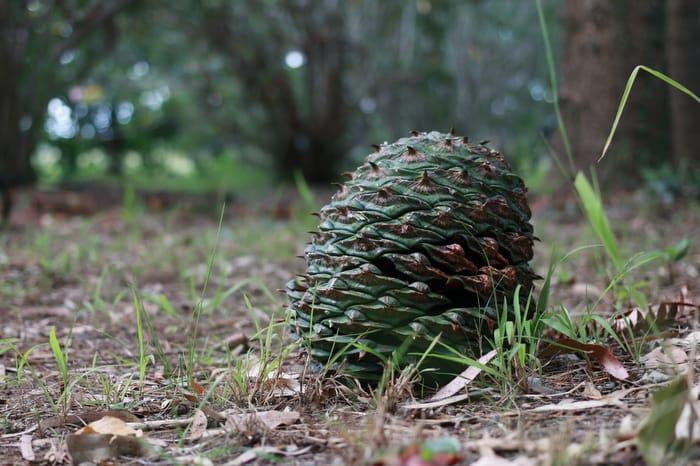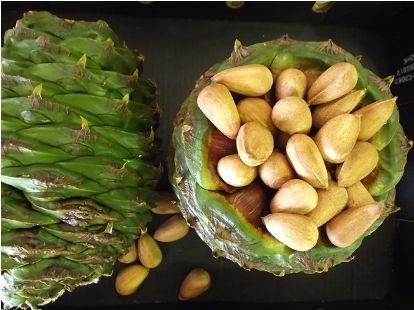The Bunya nut, a native Australian delicacy, holds a rich cultural significance.
Hailing from the towering Bunya pine, these nuts have been a vital food source for Indigenous Australians for thousands of years.
Their importance extends beyond mere sustenance. The Bunya nut has played a pivotal role in social gatherings, ceremonies, and even dispute resolutions among Indigenous communities.
However, the cultural significance of Bunya nuts is not confined to the past. Today, they are experiencing a resurgence, finding their way into modern Australian cuisine and environmental conservation efforts.
This article delves into the cultural significance of Bunya nuts in Australia. It explores their historical importance, contemporary uses, and their potential future in the realms of culture, cuisine, and conservation.
Join us as we journey through the fascinating story of Bunya nuts, a tale deeply intertwined with the rich tapestry of Australian history and culture.

The Bunya Nut: A Brief Overview
The Bunya nut is the seed of the Bunya pine (Araucaria bidwillii), a majestic tree native to southeastern Queensland, Australia.
These trees are a sight to behold, growing up to 45 meters tall and living for over 600 years. Every three years, they produce a bumper crop of nuts, an event that has been celebrated by Indigenous Australians for centuries.
The nuts themselves are large, similar in size to a chestnut. They are encased in a hard, spiky cone that can weigh up to 10 kilograms.
Despite their tough exterior, Bunya nuts are a powerhouse of nutrition. They are rich in complex carbohydrates, protein, and omega-3 fatty acids, making them a valuable food source.
From their historical importance to their potential future, the Bunya nut is a symbol of the enduring connection between people, land, and culture in Australia.
Historical Importance to Indigenous Australians
For thousands of years, Bunya nuts have been a significant food source for Indigenous Australians.
They were traditionally eaten raw, roasted, or used in a variety of dishes. The Bunya Mountains, named after the Bunya pine, were a traditional gathering place for Indigenous Australians.
Every three years, during the ‘Bunya nut festival’ or ‘Bonye Bonye’ festival, Indigenous groups would gather in these mountains. The festival was not just about the harvest of the nuts, but also served as a time for social interaction.
During these gatherings, Indigenous groups would:
- Exchange goods
- Settle disputes
- Conduct ceremonies
These gatherings were an important social event and are considered one of the earliest forms of a ‘bush tucker’ market. Unfortunately, the arrival of European colonizers disrupted these traditional gatherings and the cultural practices associated with the Bunya nuts.
Today, there is a resurgence of interest in Bunya nuts and their cultural significance, as part of the broader movement to recognize and respect Indigenous Australian culture and heritage.
The Bunya Nut Festival: A Time-Honored Tradition
The Bunya Nut Festival, also known as the ‘Bonye Bonye’ festival, is a significant event in the Indigenous Australian calendar.
Held every three years, this festival coincides with the bumper crop of Bunya nuts produced by the Bunya pine. The festival is not just a time to harvest these nutritious nuts, but also a time for social interaction and cultural exchange.
During the festival, Indigenous groups from different regions would gather in the Bunya Mountains. They would exchange goods, settle disputes, and conduct ceremonies. These gatherings were an important social event and are considered one of the earliest forms of a ‘bush tucker’ market.
Unfortunately, the arrival of European colonizers disrupted these traditional gatherings. However, today there is a resurgence of interest in the Bunya Nut Festival. It is seen as a vital part of the broader movement to recognize and respect Indigenous Australian culture and heritage.
Nutritional Value and Health Benefits
Bunya nuts are not just culturally significant, they are also a powerhouse of nutrition.
These large nuts, similar in size to a chestnut, are packed with complex carbohydrates, protein, and omega-3 fatty acids. This makes them a highly nutritious food source, especially for those following a plant-based diet.
Here are some key nutritional benefits of Bunya nuts:
- Rich in complex carbohydrates: Provides sustained energy and aids in digestion.
- High in protein: Essential for muscle growth and repair.
- Contains Omega-3 fatty acids: Promotes heart health and supports brain function.
In addition to these benefits, Bunya nuts are also low in fat and free from gluten. This makes them a suitable food choice for people with dietary restrictions or those seeking healthier alternatives to common nuts.
Bunya Nuts in Aboriginal Mythology and Spirituality
The Bunya nut holds a special place in Aboriginal mythology and spirituality.
For Indigenous Australians, the Bunya nut is more than just a food source. It is a symbol of the deep connection between people, land, and culture. This connection is often expressed through stories and ceremonies, where the Bunya nut plays a central role.
In some Aboriginal communities, the Bunya tree is considered sacred. Its towering presence and long lifespan are seen as a symbol of strength and endurance. The cyclical nature of its fruiting also mirrors the cycles of life, death, and rebirth in Aboriginal spirituality.
The spiritual significance of the Bunya nut underscores its cultural importance. It is a reminder of the rich and complex relationship that Indigenous Australians have with their natural environment.
Contemporary Uses and Bunya Nut Recipes
In recent years, there has been a resurgence of interest in Bunya nuts. This is largely due to the native food movement in Australia, which seeks to promote indigenous ingredients and sustainable food practices.
Bunya nuts are versatile and can be used in a variety of dishes. They can be eaten raw, roasted, or boiled. They can also be ground into a flour and used in baking.
Here are a few popular Bunya nut recipes:
- Bunya nut pesto: This is a twist on the classic Italian recipe, with Bunya nuts replacing the traditional pine nuts.
- Bunya nut soup: A hearty and nutritious soup, perfect for the colder months.
- Bunya nut bread: A dense and flavorful bread, ideal for those looking for a gluten-free option.
These recipes highlight the culinary potential of Bunya nuts. They also demonstrate how traditional ingredients can be incorporated into modern cuisine, creating a fusion of flavors that is both delicious and culturally significant.
Conservation and Environmental Significance
The Bunya pine, from which the Bunya nut is harvested, is a significant part of Australia’s natural heritage. It plays a crucial role in the ecosystem, providing habitat and food for a variety of wildlife.
However, like many native species, the Bunya pine faces threats from habitat loss and climate change. Conservation efforts are therefore essential to ensure the survival of this species and the continued availability of Bunya nuts.
The cultivation of Bunya pines is also seen as a way to promote reforestation and environmental conservation. By planting and protecting these trees, we can help to preserve Australia’s unique biodiversity and contribute to the fight against climate change.
In this way, the Bunya nut is not just a food source, but also a symbol of the interconnectedness of people, land, and culture. Its conservation is a testament to the enduring cultural significance of this humble nut.
Challenges and Opportunities in Commercialization
Commercializing Bunya nuts presents both challenges and opportunities. One of the main challenges is ensuring that the cultural significance of the nut is respected. This includes acknowledging the traditional knowledge of Indigenous Australians and ensuring that they benefit from any commercial activities.
On the other hand, the commercialization of Bunya nuts could provide economic opportunities for Indigenous communities. It could also help to raise awareness about the cultural and environmental importance of the Bunya pine.
However, it is crucial that any commercial activities are conducted in a sustainable and ethical manner, to ensure the long-term survival of the Bunya pine and the cultural practices associated with it.
The Future of Bunya Nuts: Cultural Revival and Sustainability
The future of Bunya nuts is intertwined with the cultural revival and sustainability of Indigenous Australian communities. As interest in native foods and sustainable practices grows, so does the potential for Bunya nuts to play a significant role.
Efforts are underway to integrate Bunya nuts into educational programs about Australian flora and Indigenous culture. This not only fosters a sense of identity and continuity among Indigenous Australians but also promotes understanding and respect among non-Indigenous Australians.
The potential for Bunya nuts to be a flagship species for conservation and cultural heritage in Australia is immense. They symbolize the connection between people, land, and culture, and their cultivation can contribute to environmental conservation and reforestation.
In the face of global challenges such as climate change and food security, Bunya nuts offer a beacon of hope. They represent a bridge between traditional knowledge and modern science, and their story is a testament to the resilience and survival of Indigenous Australian cultures.





Leave a Reply